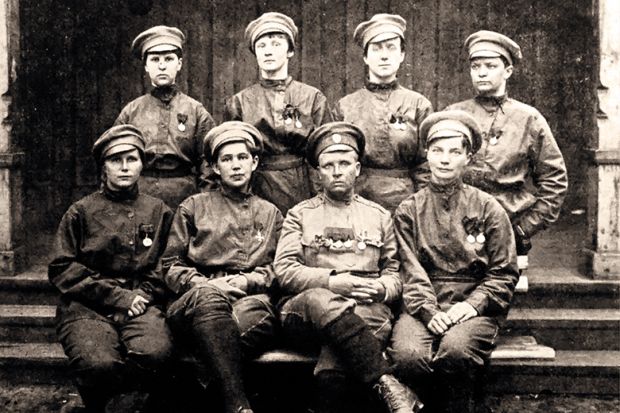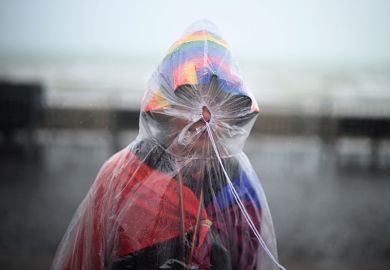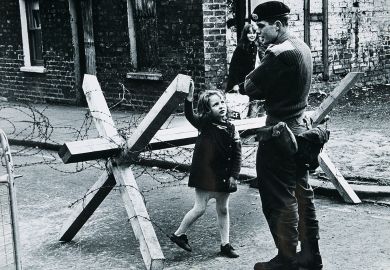I finished reading Julie Wheelwright’s ambitious book on the same day that I went to see director Sam Mendes’ 1917. In near forensic detail, the film follows two young British soldiers tasked with a hazardous mission in occupied France. What it does so well is to show what happens when we try to understand stories of war by personalising them: it works because we get to know the two main protagonists, and to feel for – and with – them. Perhaps unavoidably, however, Mendes’ film tells a story exclusively about white masculinity. Few people of colour contribute to the action, and the only female character is almost entirely ancillary to the dominant narrative trajectory.
In Sisters in Arms, Wheelwright rejects the received wisdom that women have been little more than bit players in men’s heroic adventures. She shows instead how they have always had a significant presence and influence in times of armed conflict. The book is published by Osprey, the specialist military history imprint, and is fundamentally a much-expanded and updated version of her Amazons and Military Maids, published more than 30 years ago. As in that earlier book, in Sisters in Arms Wheelwright tells many stories about women warriors, wresting them from history’s footnotes and lacunae, and placing them firmly centre stage.
Wheelwright’s is an extensive cast marshalled into three broad categories. We hear about the wives of service personnel who got unintentionally caught up in armed conflict; we meet women who wanted to enlist so badly that they “disguised themselves as men” in order to “travel, to flee poverty, an abusive husband or a future filled with drudgery”; and, finally, we learn of those women who were “granted exceptional permission” to serve as themselves.
In the same year as Mendes’ fictional narrative, the redoubtable Lieutenant Maria Bochkareva’s 2,000-strong, and rather ominously named, Russian Women’s Battalion of Death, was inspected by none other than Emmeline Pankhurst. Contemporary accounts strategically positioned Bochkareva’s as a story of female sacrifice, and she quickly gained a near-celebrity status. Wheelwright’s account of her is gripping: among Bochkareva’s soldiers, we’re told, “Giggling was strictly forbidden and within two days of their signing on, she had dismissed more than eighty women for laughing too much.”
Wheelwright is at her strongest in vivid moments such as this. She gives her subjects space to speak for themselves, shedding light on, for example, the journals and personal correspondence of two American Civil War soldiers: Jerome Robbins and Frank Thompson. “My friend Frank is a female” is Robbins’ understated diary entry late in 1861 (he later sealed the pages with glue to protect the “confession from accidental discovery”). Robbins struggled “to make sense of his conflicted feelings for Sarah [Edmonds, alias Frank] as a woman and as a fellow medic working in an all-male environment”, Wheelwright tells us, but the two maintained their “remarkable friendship” even after Frank’s desertion in 1863 with another soldier, James Reid. The story is enthralling, and Wheelwright navigates its Gordian complexities skilfully.
Sarah Edmonds, then, is one “passing woman warrior” among many in Sisters in Arms who appears to have had a heterosexual relationship with another combatant. Hannah Snell “passed” in the 18th century as a British marine called James Gray, and pursued relationships with “other women, to satisfy her own desires, or as a means to consolidate her masculine persona”.
Gray exhibited such “bravado and skill” that his (Wheelwright uses the masculine pronoun when Gray, rather than Snell, is the subject of a sentence) peers came to regard him as “indispensable”. His hypermasculine behaviour, driven by having been teased about his “hairless chin” and perceived effeminacy, “quashed rumours about his sex”. Further, Gray cultivated a relationship with a woman in Portsmouth, to the point where, when he “boasted of his new love, his mates approved and accepted their shipmate’s excuse for avoiding harbour brothels”.
Even when the women in Sisters did not need to pass – as with Bochkareva – their identities were still fluid. In the First World War, Serbian Sergeant-Major Flora Sandes wore a dress to a party. She later recalled her fellow soldiers pleading with her to change the outfit and, as Wheelwright puts it, hide “her female body behind her uniform”. Sandes’ story exemplifies the contradictory figure of the woman soldier whose “exceptional position” could rapidly be transformed into “public spectacle”. (Incidentally, Sandes was later to capitalise on this reputation as spectacle: in 1920, she undertook a speaking tour of Australia. “Her female audience surely admired how she escaped her suburban spinster’s life”, writes Wheelwright, “to become an international celebrity: despite the uniform, they embraced her as one of their own.”)
The whistle-stop account of women in warfare presented in Sisters in Arms begins – as the book’s title suggests – with the Amazons and Scythians, and ends with Putin’s paratrooper Yulia Kharlamova, taking in Joan of Arc and many others along the way. The book’s central focus on the culturally ambiguous figure of the woman warrior is clear, even when Wheelwright’s account hurtles from conflict to conflict across time and space, and her vignettes are effective because of her scrupulous attention to contemporary detail. Her chapter on Russian women who “present themselves as care-givers, morally superior, spiritual beings who enter combat only as proxies for inadequate men”, however, has the air of an afterthought, which diminishes some of the impact of the preceding section on the bleak history of sexual assault and rape in the armed forces (research carried out by the Pentagon after the Gulf War demonstrated that even female soldiers who had been prisoners of war were more likely to have been sexually assaulted at some point by combatants on their own side than by enemies).
Sisters in Arms (or, as I came to think of it, “Hers Ancient and Modern”), then, has a historical and geographical range that might, in the hands of a less engaging writer, simply have been too much to tackle credibly. But, as Wheelwright puts it, these apparently diverse sisters in arms, when brought together like this in one sustained analysis, remind us that “women’s negotiation for their right to equality is as ancient as the tombs in which the Scythian warriors lie buried along the shores of the Black Sea”. In traversing both centuries and continents, her narrative serves to show a world where intractable gender roles persist, only to be even more vividly rendered in times of war.
Emma Rees is professor of literature and gender studies at the University of Chester, where she is director of the Institute of Gender Studies.
Sisters in Arms: Female Warriors from Antiquity to the New Millennium
By Julie Wheelwright
Osprey Publishing, 320pp, £18.99
ISBN 9781472838001
Published 20 February 2020
The author
Julie Wheelwright, senior lecturer and programme director in creative writing at City, University of London, was born in Kent but moved to Canada at the age of two and grew up in British Columbia. She studied history and English at the University of British Columbia, where she worked on the student newspaper.
As part of her MA in history at the University of Sussex, she recalls, she “researched the debate around British women’s participation in auxiliary services and in combat in the First World War, which led to my first book [Amazons and Military Maids: Women Who Dressed as Men in Pursuit of Life, Liberty and Happiness (1989)]. My PhD in journalism at City, University of London introduced me to postmodernism’s challenge to historians on questions of narrative subjectivity, how we shape evidence and our commitment to truth claims, all of which are equally important to journalism.”
Her own journalism, in Wheelwright’s view, has influenced her historical writing because “you develop an intuitive understanding of narrative. I write along the borderlands of these disciplines, as I use archival sources to write scenes, search out telling details about individuals or interrogate sources for information about emotional states. This has enriched my approach to history as a genre of writing in which imagination and empathy are relevant.”
So how can knowledge of women’s historical combat roles influence attitudes and actions today?
“The women who defied social conventions to enter the military were important historical figures”, responds Wheelwright, “because they disrupted the narrative of war as an exclusively male sphere. Many female readers of these stories regarded them as heroic figures and were inspired to enact their own forms of resistance…The resistance they faced may resonate for contemporary servicewomen and for women in a vast range of male-dominated occupations.”
Matthew Reisz
POSTSCRIPT:
Print headline: Women, to the front!
Register to continue
Why register?
- Registration is free and only takes a moment
- Once registered, you can read 3 articles a month
- Sign up for our newsletter
Subscribe
Or subscribe for unlimited access to:
- Unlimited access to news, views, insights & reviews
- Digital editions
- Digital access to THE’s university and college rankings analysis
Already registered or a current subscriber? Login







